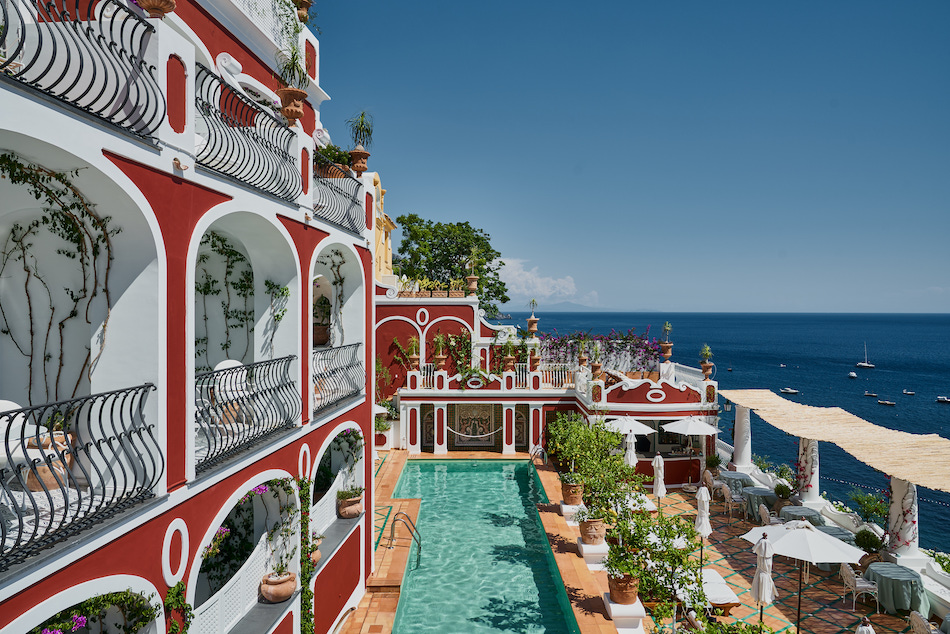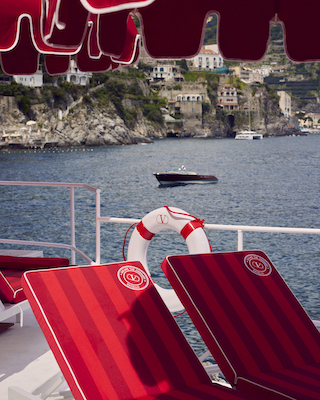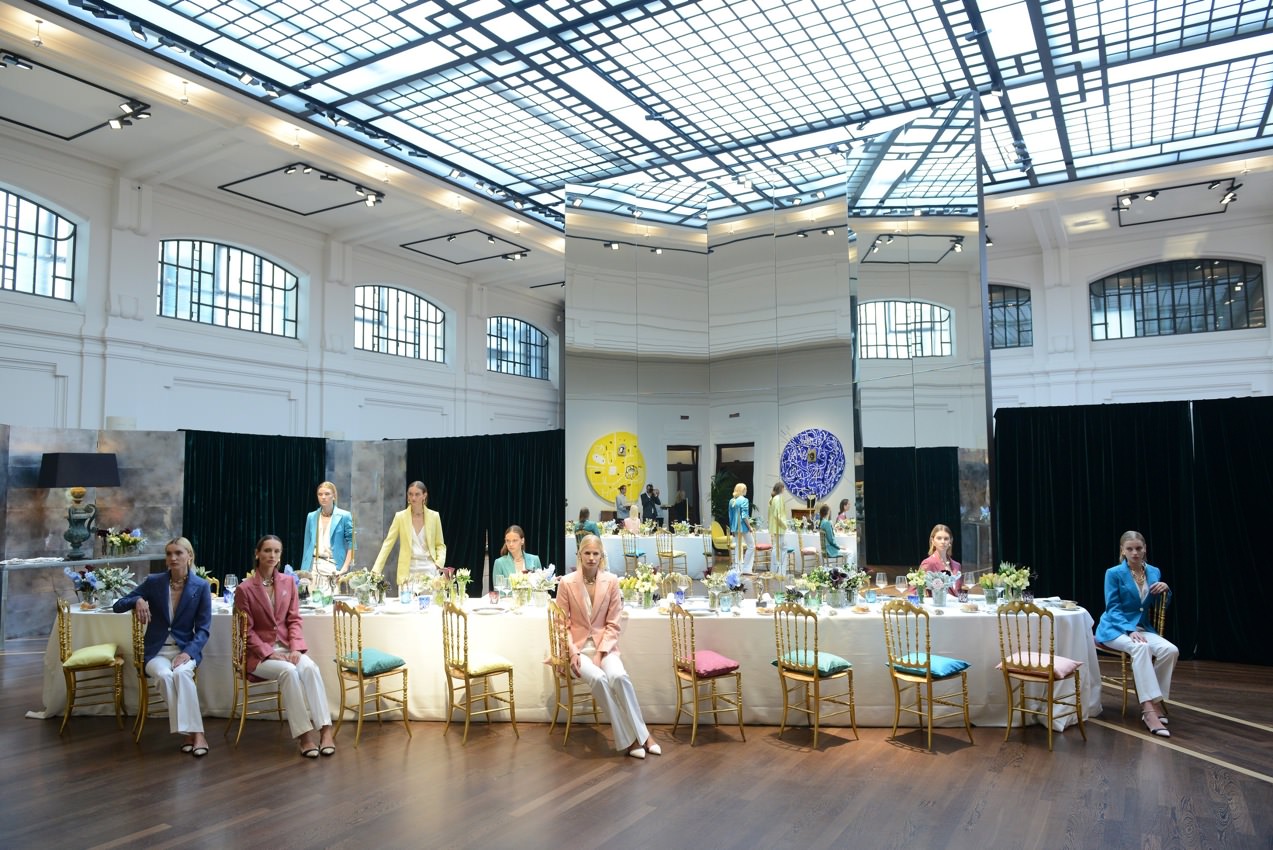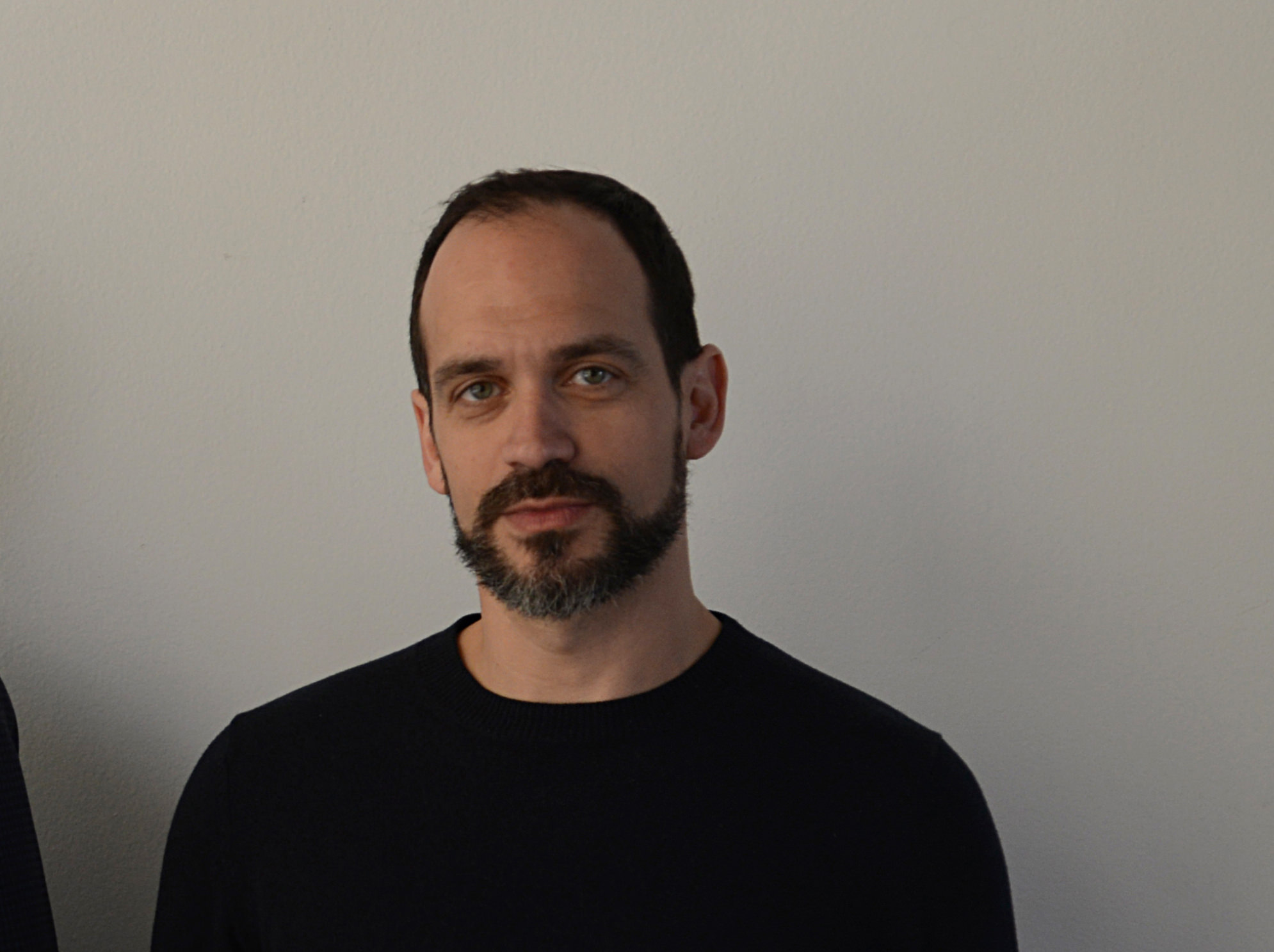In 1854, a monumental engineering feat was completed in Southern Italy, connecting the Amalfi Coast to the rest of the world. Inaugurated by King Ferdinand II of Naples, it was then that a long, unpaved road began to snake around the region’s tiny towns, bringing locals and visitors alike down its narrow path to a well of inspiration centered by the sea. After World War II, many global visitors were drawn to the destination’s relaxing atmosphere, romantic scenery, and mild climate—from artists and writers to performers, dignitaries, and movie stars—as they are today.
The coat’s nearby urban city, Naples, remained a hub for year-round living. With business built on more than fishing and produce, it was here that many Southern Italian families lived and traversed to the Amalfi Coast from on weekends. Over the years, one city in particular, Positano, grew familiar with this multi-city cultural awakening, becoming a safe, inspirational haven on the coast. Tucked between the ocean and steep mountains dotted with summer homes, the city was alive long before the road was revealed and travelers arrived, tied to changes from as far back as the Middle Ages when local merchants would sail through the Mediterranean.
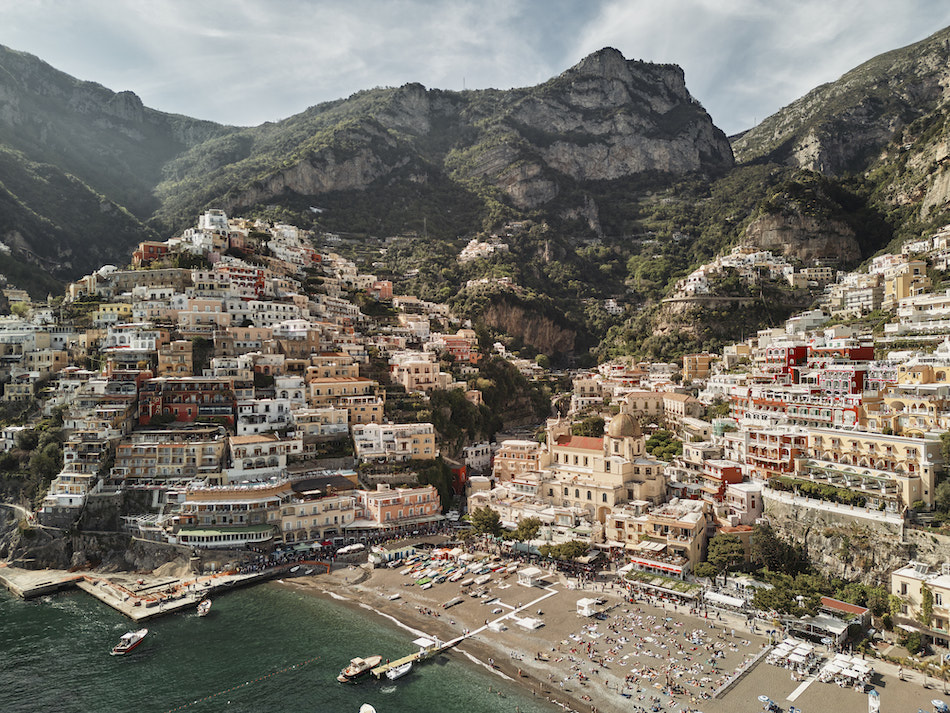
Positano, courtesy of Le Sirenuse.
In 1951, one Naples-based family, the Sersales, turned their Positano summer villa, Villa Giulietta, into a hotel and named it Le Sirenuse. Opened by four siblings—Paolo, Franco, Anna, and Aldo—the hotel was titled after the original name of the three islands that sit off the coast of Positano, now named Li Galli. Dating back to the Greek mythological tale of “le sirenuse,” or “the mermaids,” it is said that these gorgeous charmers lured passerby sailors into treacherous seas with an irresistible song. Now, Le Sirenuse’s logo pays homage to these mermaids.
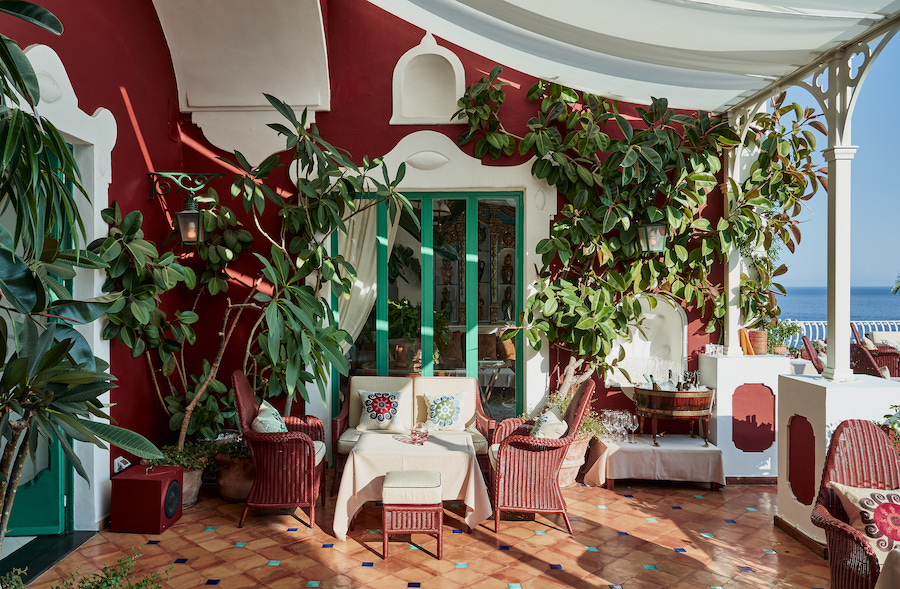
Courtesy of Le Sirenuse.
Since its opening, Le Sirenuse has acted as a respite for many creatives and public figures, including film stars, military generals, artists, and royalty. It has also undergone natural evolutions and thoughtful renovations while remaining a property that solely belongs to the family. Each founding member of the converted villa also holds personal tales, including Paolo Sersale who was mayor of Positano at just 24 years old, where he served from 1944 until 1960.
Their children, who became integral parts of the hotel’s progress and success, too, also hold their own ties—including Paolo’s daughters Guila, who oversees the property’s unforgettable botanicals, and Marina, who founded the fragrance and body care line, Eau d’Italie. Notably, in 1992, Franco’s son, Antonio, became Le Sirenuse’s co-owner and general manager, which are positions he still holds today.
With these titles, Antonio has embraced his father’s passion for art and developed a collection and commission program at the hotel. In 2015, he partnered with the British curator Silka Rittson-Thomas to bring it to life, first bringing in Martin Creed in 2016, who created a DON’T WORRY neon for its third-floor bar. Since, artists like Stanley Whitney, Alex Israel, Matt Connors, and Rita Ackermann have produced site-specific works in response to the space’s one-of-a-kind environment. Other pieces—from furniture and tapestries to historical portraits and artifacts—are seen throughout the property.
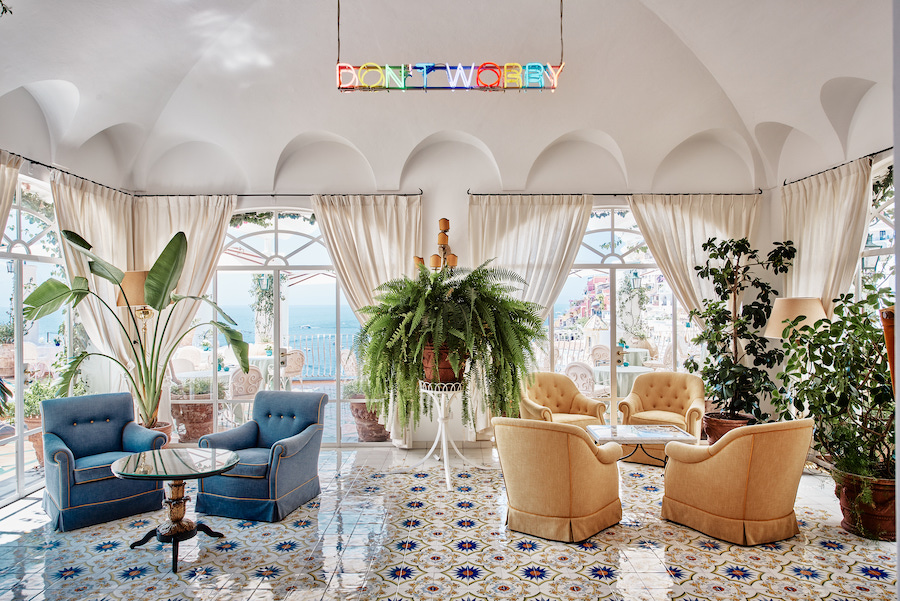
Courtesy of Le Sirenuse.
Additionally, Antonio has put a premium on its food and beverage offerings, turning its restaurant, La Sponda, into a dining destination, and opening two more spots: Aldo’s and Franco’s, both located on terraces. Sumptuous cuisine embraces local flavors and recipes while remaining true to the area’s seasonal offerings, including fresh fruit, fish, and of course, handmade pasta.
Antonio’s wife, Carla, and their two children, Francesco and Aldo, are also part of the family business. Carla owns and operates Emporio Sirenuse—a contemporary fashion label that encompasses men’s and women’s clothing, hotel merchandise, and home products—and spearheads many artistic collaborations with artists, designers, and philanthropic organizations, too. Recently, Emporio Sirenuse’s men’s and women’s boutiques across the street from the hotel underwent gorgeous design renovations by Rosseel Studio, greeting guests to tiled floors, walls, and display cases that echo the surrounding Meditteranean hues.
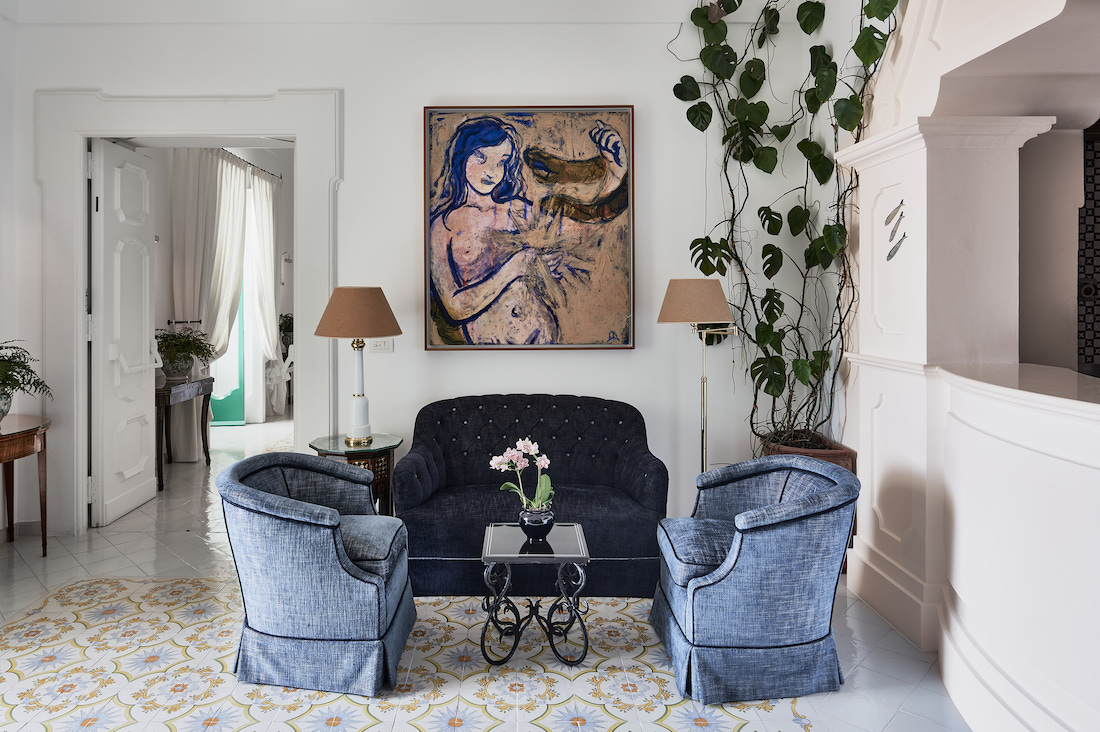
Photo by Brechenmacher & Baumann, courtesy of Le Sirenuse.
For Francesco and Aldo, a career with family was also some sort of kismet. After both sons spent time in the United States hospitality and management industries, Francesco returned to Le Sirenuse to lead marketing and partnerships, while Aldo is rooted in its operations. Both sons bring their experiences back home to elevate the hotel’s image and prospective partnership opportunities, from what it publishes on its Instagram page to which brands its merchandise line partners with.
Recently, we had the pleasure of venturing to Positano and touring Le Sirenuse with the Sersales, who showed us their slice of the world. In the morning, we had espresso and walked through its extensive morning buffet at La Sponda, complemented by global newspapers and Italian treats like bombolone, while enjoying the incomparable view of the Santa Maria Assunta church brimming the sea. In the evening, aperitivo hour drew us to the terrace to watch the sunset’s glow wash over the shoreline boats while we twirled Spaghetti alla Nerano—a zucchini pasta dish, with a famed recipe gained from its neighboring town. Immersed in relaxation, we boarded the family’s boat in the afternoon, trekking toward Praiano and back, and snoozed poolside after sunbathing with a Lemon Spritz in hand. Colorful cliffside views, blending into the Tyrrhenian Sea, created a mirage of luxurious landscape sights for sore eyes.
Whitewall spoke with Antonio, Carla, Francesco, and Aldo about their multi-generational family tradition, Le Sirenuse, and why its core values will never change.
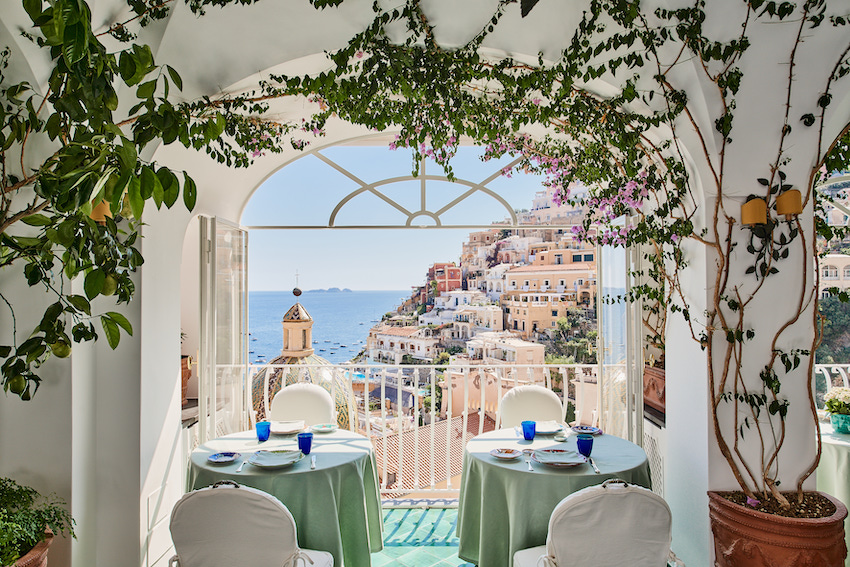
La Sponda, courtesy of Le Sirenuse.
WHITEWALL: Le Sirenuse has been a family-owned and -operated space from the start. Antonio, what values did your father or family pass down that you still instill in the hotel today?
ANTONIO SERSALE: One thing my father taught me that still runs in the DNA of how we run Le Sirenuse is to never underestimate your guests. Our guests are well-traveled, well-read, cultured, and knowledgeable, so we work on that basis when making our decisions. We do not cut any corners as a result, always opting for the highest quality and most sophisticated solution, no matter if it is more difficult or impractical.
WW: What aspects of the hospitality landscape have changed most since you took the helm of the hotel in 1992?
AS: We offer a whole set of activities that we did not offer before, such as walking excursions with a guide, boat rides, a tour to the fishmonger, a flower tour of the Hotel, and Pilates classes.
We have also opened two new food and beverage outlets, Franco’s and Aldo’s, which have completed our offering. The concept in our main restaurant La Sponda has also completely changed to one much closer to the traditional cuisine of this area.
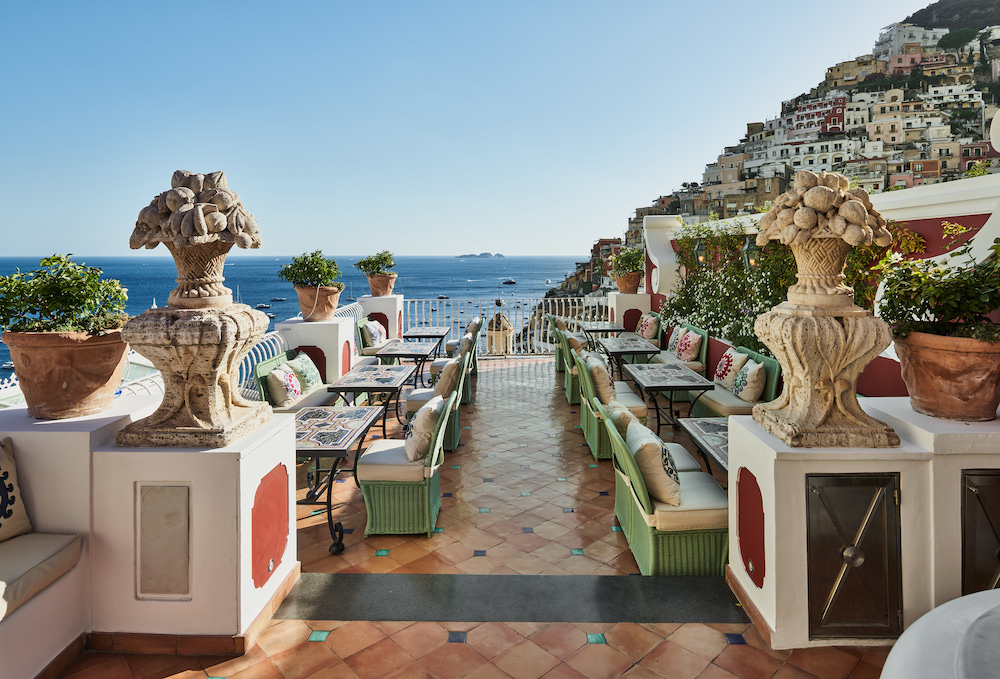
Aldo’s, courtesy of Le Sirenuse.
WW: The hotel is filled with art and design details, with found and commissioned work seen throughout. Where did your interest in art begin?
AS: I have always had a passion for art. In the last few years, I have embraced contemporary art and started the artists at Le Sirenuse program, which consists of a series of site-specific installations commissioned for the hotel.
WW: Tell us about the unique artworks, furniture, and design objects that fill the space—like artworks by Alex Israel, Martin Creed, Rita Ackermann, etc.
AS: The main authority behind much of the antique furniture and objects in the hotel was my late father Franco. He enriched Le Sirenuse with hundreds of beautiful objects, and always knew exactly where to place them. Often, this would be a guest room. For Franco’s, these were just as important as the “public” parts of the hotel. Much of the furniture or art he assembled is firmly in the 17th and 18th century Neapolitan and southern Italian tradition that is the bedrock of Le Sirenuse’s aesthetic. But Franco had eclectic tastes, and there are plenty of neo-Moorish items too—not to mention an important collection of Central Asian suzani rugs.
In 2015, I started a contemporary art program. Working together with British curator Silka Rittson-Thomas, we invited leading international artists to create works for the hotel. We started with Martin Creed in 2016 who hung a DON’T WORRY neon in our main third-floor bar. Since then, artists of the caliber of Stanley Whitney, Alex Israel, Matt Connors, and Rita Ackermann have produced site-specific works exclusively for Le Sirenuse. With each new work, the challenge of finding the perfect home amidst the hotel’s busy design scheme becomes more difficult—and for that very reason, more enjoyable.
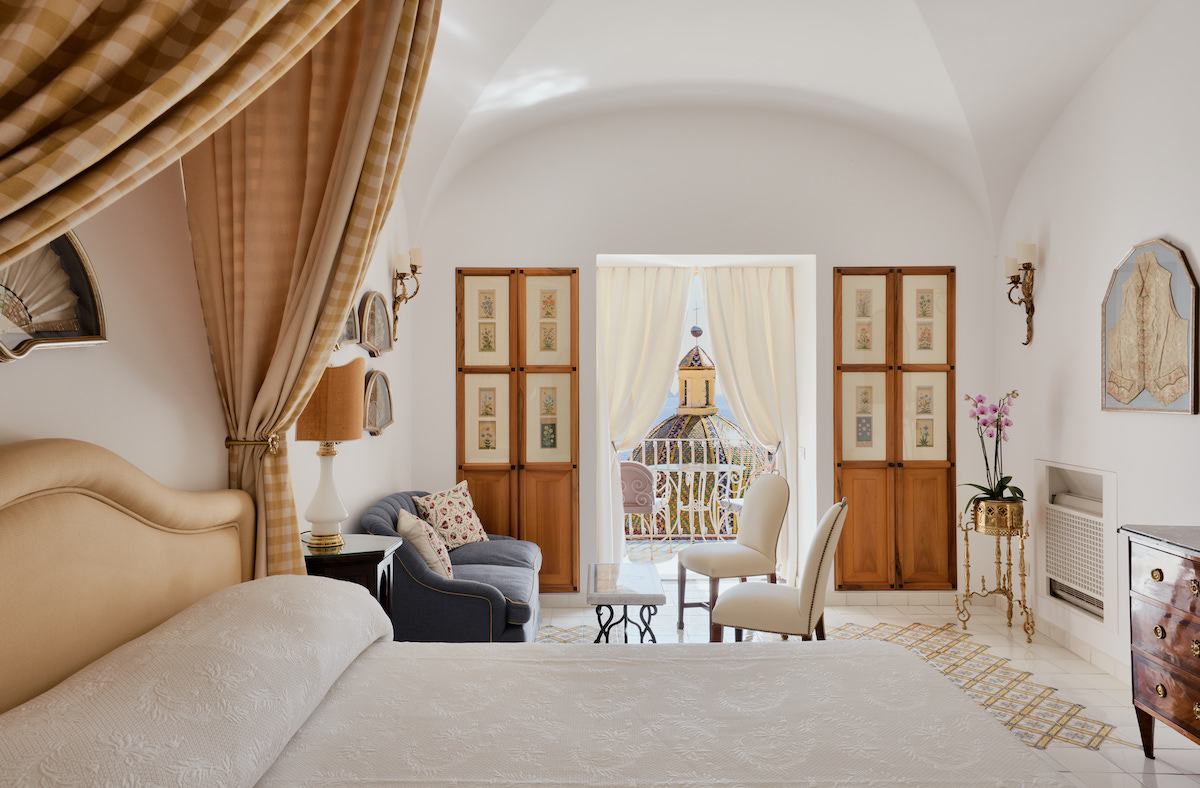
Courtesy of Le Sirenuse.
WW: What’s seen in your home?
AS: Books, textiles, objects found and bought through trips abroad, and contemporary paintings.
WW: We’ve experienced many cultural changes in recent years, and even endured a global pandemic. How did COVID-19 impact the way you thought about owning and operating a hotel? Were there any changes once it re-opened?
AS: Covid was, in the long run, beneficial for our business. It forced us to take a step back and re-evaluate the business. We took a magnifying glass to every individual outlet and department, looking for ways to work more efficiently without subtracting from the experience. We thought of new ways to market the property and attract guests. All of this crisis-induced innovation turbo-charged the property once COVID-19 ended.
WW: In Italy, food is a love language. How are you working with your F&B teams to create menu items that honor quintessential Italian dishes, and flavors of the future? On the menu, there is a Nerano pasta and a lemon spritz, but also sashimi and Old Fashioned cocktails.
AS: The emphasis is very much on local ingredients that make up the base of our beverage and food offerings. We source our ingredients locally and ensure their maximum quality and freshness. This together with a chef native of the Vesuvio area makes for a simple cuisine where the individual ingredients are at the center of the dish. Fish, vegetables, and ripe fruit, together with meat that are all locally sourced, is the secret.
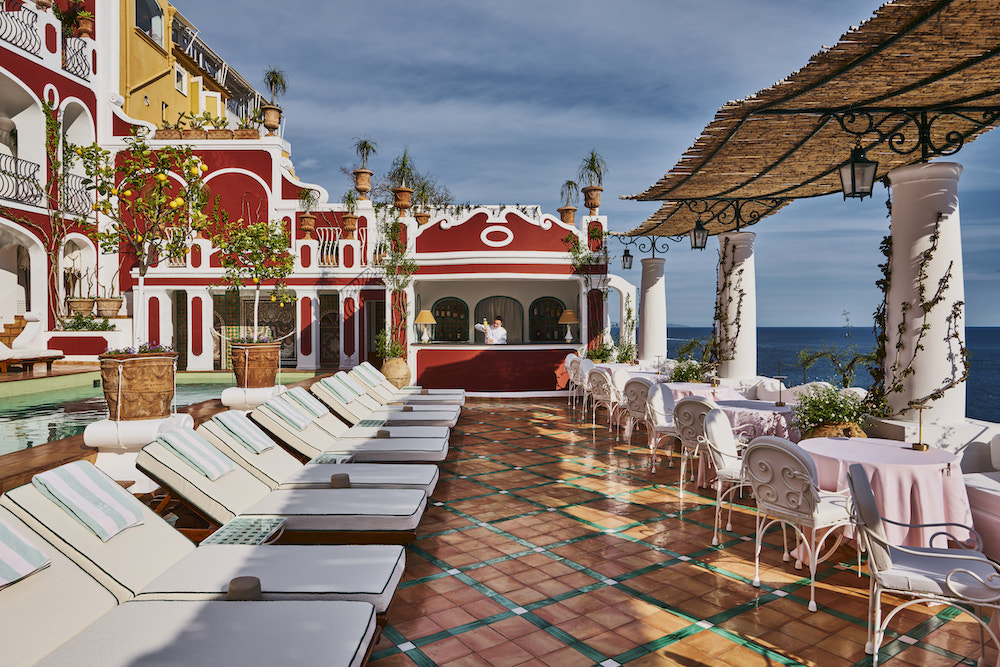
Courtesy of Le Sirenuse.
WW: Your sons, Francesco and Aldo, are part of the business and its future. What do you feel their generation—in schooling, interest, experience, etc.—provides Le Sirenuse that helps it evolve into the next generation?
AS: Our sons came back with a fresh perspective and new energy. We are expanding the business thanks to their return. Their drive and motivation have not only led to significant improvement in many areas of the hotel but also allowed us to take a step back and work more on the big picture.
WW: Carla, please tell us about your latest Emporio Sirenuse collection. What inspired it?
CARLA SERSALE: Emporio Sirenuse’s latest collection, High-Summer 2023 is all about elephants and wildlife. Palms have always been a recurrent theme in our prints and embroideries, as they are very much part of the Mediterranean culture that inspires all that we do, and so this collection saw the addition of elephants and tigers in various fashions.
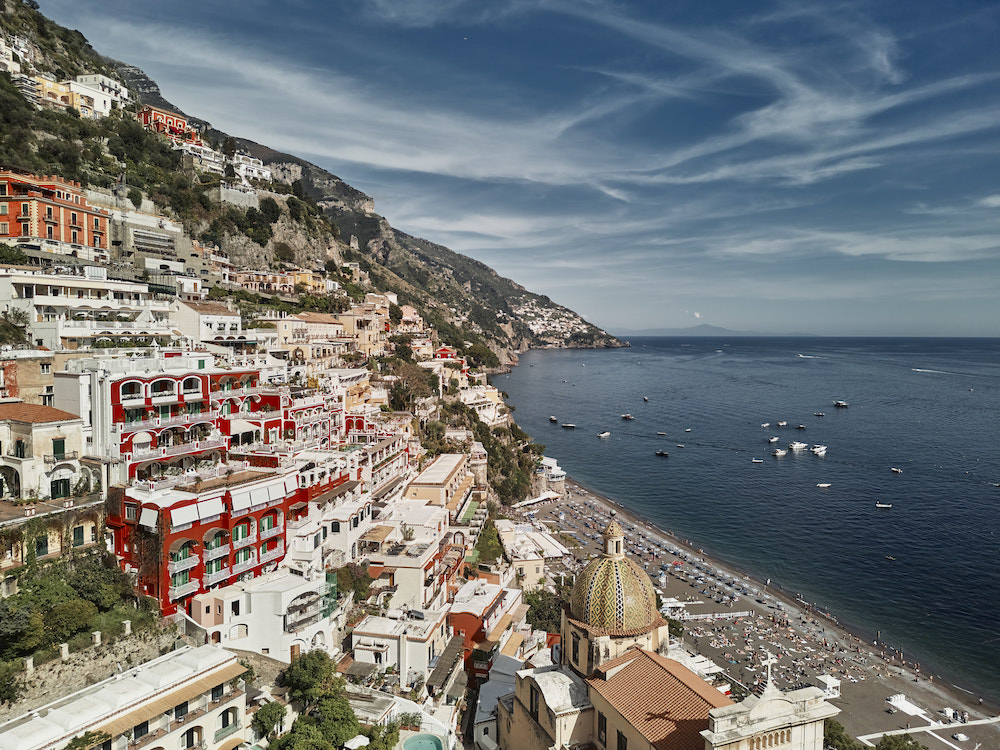
Positano, courtesy of Le Sirenuse.
WW: Le Sirenuse and Emporio Sirenuse have partnered with philanthropic organizations, like Elephant Family, for years. What is your relationship like with philanthropy? How does that impact your life?
CS: We’ve long been convinced that Italy and India have more in common than meets the eye. Think of the importance of the family in both cultures, the love of fine craftsmanship—not to mention the great food.
A meeting of Positano style and Indian life force, as well as a desire to give back to a country we love and admire, lies behind the latest collaboration launched by Emporio Sirenuse in June 2023. The High-Summer 2023 Collection honors the work in South Asia of the non-profit organization Elephant Family with a contribution of 10 percent of all profits on the sale of items.
Elephant Family was co-founded in 2002 by the late author and conservationist Mark Shand, ten years after the publication of his bestselling book Travels on My Elephant. The charity’s work has grown to encompass not only the challenges facing Asia’s wildlife but also support for the rights and essential knowledge of the indigenous and forest-dwelling communities that live alongside the animals. Around the same time that Shand was setting up the foundation, Emporio Sirenuse’s founder Carla Sersale and creative director Viola Parrocchetti, both of them great Indophiles, began to entrust the production of many of the garments in their collections to weavers, tailors, seamstresses and colorists in a number of small, ethically-run Mumbai, Delhi, and Kolkata workshops where mutually supportive family groups are the norm.
Based on a series of joyful nature-loving prints by Emporio’s creative director Viola Parrocchetti, the new collection is supported by a campaign shot by leading Italian photojournalist Sergio Ghetti on location at the Dera Amer luxury tented camp and elephant sanctuary in Jaipur, where the Singh family’s commitment to facilitating the harmonious co-existence of local communities and wildlife offers a thriving example of the Elephant Family’s mission.
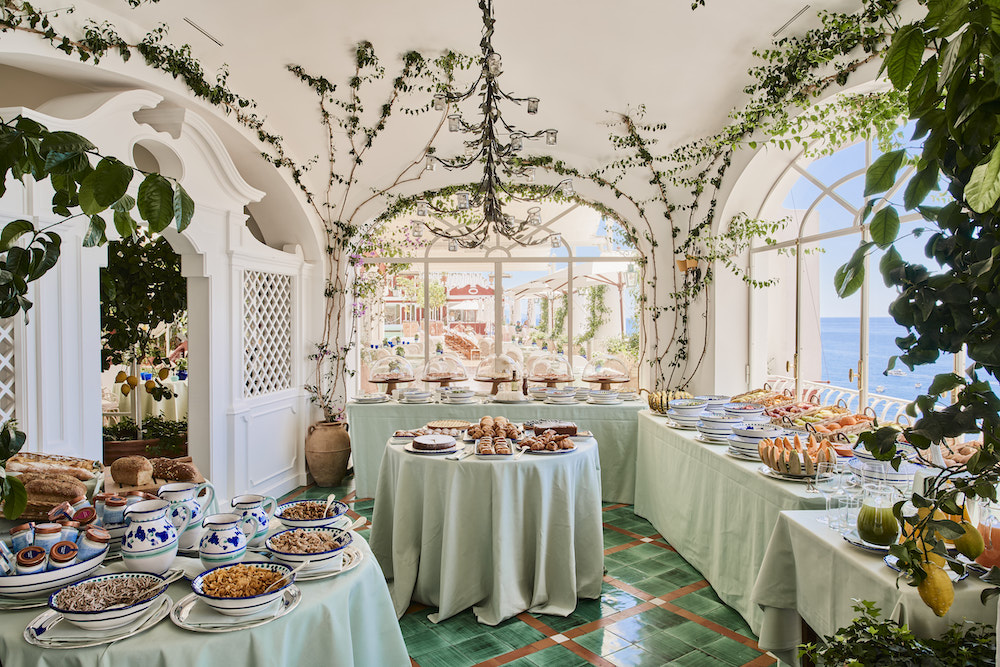
La Sponda, courtesy of Le Sirenuse.
WW: Recently, the men’s and women’s Positano stores were redesigned by Anne-Sophie Rosseel, a New York-based interior designer who specializes in retail and commercial spaces. How would you describe the restyling of the space? What is seen inside?
CS: The restyling of our Emporio Sirenuse flagship stores is a celebration of elegance, tradition, and innovation. Rosseel Studio has masterfully captured the essence of our brand, creating spaces that blend classic and contemporary elements effortlessly. We are thrilled to invite our clients to experience these inspiring spaces as they host many exciting new seasons to come in Emporio Sirenuse.
Rosseel Studio took on the challenge of creating elegant, yet intimate spaces within the boutiques’ tiny footprint, capturing the welcoming spirit and understated style of the Sirenuse family in a spontaneous blend of classical and contemporary elements. In the Women’s Boutique, floating glass shelves eliminate clutter, echoing the light-filled greens of the Tyrrhenian Sea, while integrated storage solutions like the wooden carabottino cabinet lining the back wall—reminiscent of yacht design and the architectural detailing of Carlo Scarpa—both optimize storage capacity and serve as a hanging display thanks to specially designed hooks sourced from the Belgian goldsmith, Maison Vervloet.
The boutique’s sinuous brass racks add wave-like movement to the space, while a treasure chest-like jewelry display in red Travertine and a selection of custom-craft ceramic stools, vases, and wall sculptures by ceramic artist Prince of Sun—all inspired by the myths, and legends of the Amalfi coast—bring unique ambiance to the interior. Made of extra-thick glass with brass pins, the illuminated central display table pays homage to those designed by Pietro Chiesa and Gio Ponti for Fontana Arte, while the original hand-painted ceramic tile floors and sculptural Aqua Creations chandeliers remain as iconic fragments of the original space.
For the men’s boutique, Rosseel deliberately differentiated the design and atmosphere, using a clean framework to create a sense of calm familiarity. The minimalist palette and slatted, modular shelving system in white lacquered wood allows the Suzani motifs of the brand’s signature Home Collection, colorful Hawaiian shirts, and swimwear to stand out, as well as providing flexible merchandising options. Distinctive blue-tinted mirrors with milled frames inspired by a Camogli holiday home designed by Alberto Seassaro expand the dimension of the store, calling to the sea beyond while engaging the client by reflecting their presence within the interior.
A sleek backlit glass display table and blue marble window display showcase the store’s extensive selection of blown Carlo Moretti glass, while the inclusion of Prince of Sun ceramics, signature brass finishes, and the original chandeliers and tiled floors add subtle touches of creative charm, connecting the aesthetic to that of the Women’s boutique next door. As a testament to Emporio’s focus on creative collaboration and desire to bring local traditions into the world of contemporary style, all custom millwork was master crafted by expert Italian craftsmen, while the lighting design was executed by Herve Descottes of L’Observatoire International.
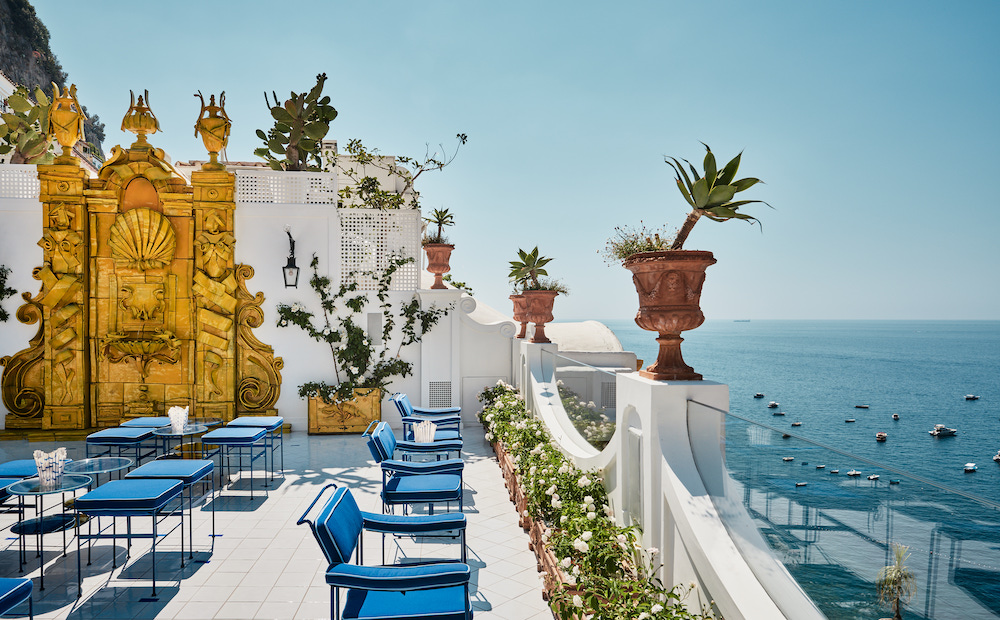
Franco’s, photo by Brechenmacher & Baumann, courtesy of Le Sirenuse.
WW: What does Le Sirenuse of the past and present have in common with its future? What might look different in the next 30 years?
AS: Le Sirenuse’s core values have never and will never change. Our dedication to excellent design and craftsmanship throughout the hotel, attention to detail, and friendly southern Italian charm are things that you will always find at Le Sirenuse. We are, however, extremely dedicated to keeping up with the technological innovation in the hotel—from innovative spa treatments and Dyson products in the rooms to our website and Instagram page. These are the things you will see change with the times.
WW: What is the hotel working on for its re-opening in the spring?
AS: Next Spring, we will be hosting our annual health and fitness retreat Dolce Vitality in March, right before the hotel opens for the season. Like-minded guests, who have the hotel to themselves for the week, explore breathtaking views through hikes in the mountains of Positano, enjoy natural local food, and practice yoga, pilates, and meditation.
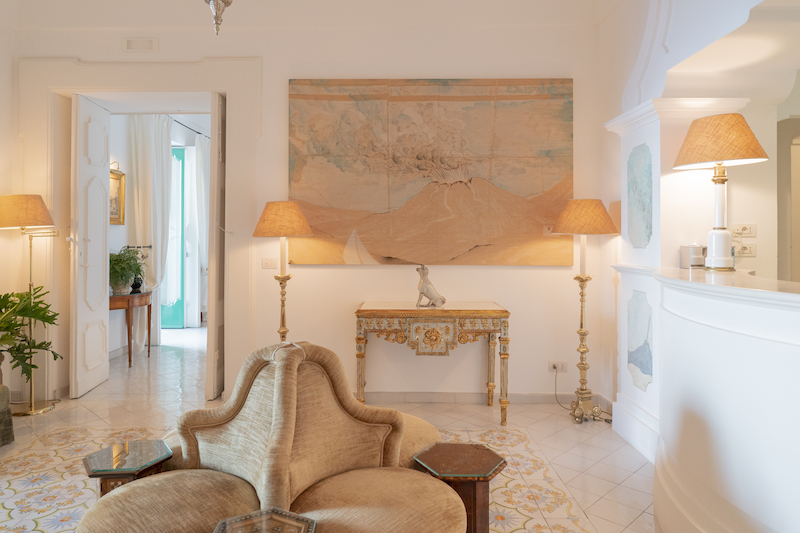
Photo by Brechenmacher & Baumann, courtesy of Le Sirenuse.
WW: Aldo and Francesco, why are you interested in continuing the family business, instead of pursuing another professional realm?
ALDO SERSALE: We are very passionate about continuing the business. It has been in the family since it was converted from a summer home in 1951, with each generation adding its touches and improving the property. After working in NYC for five years (Aldo at managing F&B at the Mandarin Oriental, and Francesco an agent at WME), it felt very natural to come back and begin working alongside our incredible parents and the wonderful world they have built.
WW: Francesco, you lead many of Le Sirenuse’s marketing and partnership efforts. The hotel often collaborates with brands on products and activations—such as KOIO and Tombolo. When does collaboration make sense? What must it have in common or in contrast with Le Sirenuse?
FRANCESCO SERSALE: There is no template or set of rules that govern who we collaborate with, we take it step by step. In the case of Tombolo, they were a perfect partner to bring something super fun and different to the Emporio Sirenuse boutiques. It added a different dimension to the stores, and our guests loved them.
In the case of KOIO, they represent many of the same values as we do. Their shoes are made of the highest quality and standards by one of the most highly regarded shoe-makers in Italy. The limited-edition capsule collection is inspired by a shared love of Italian style, artisanship and attention to detail. It just made sense.
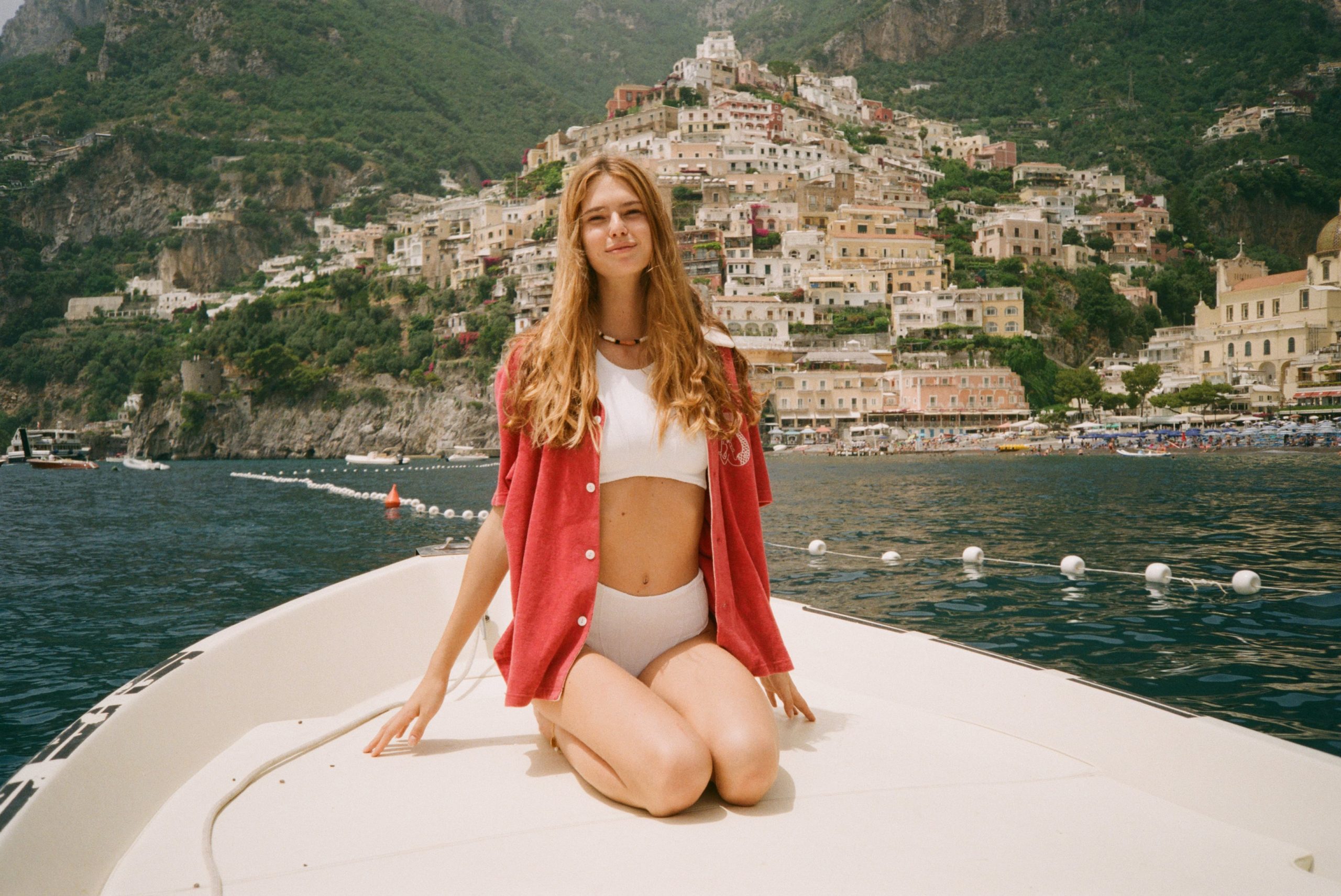
Le Sirenuse x Tombolo, courtesy of Tombolo.
WW: How does having a finger on your generation’s pulse impact programming, partnerships, or amenities at Le Sirenuse?
FS: The competition is tough in Italy alone. There are many incredible independent hotels, so you have to work hard to stand out and leave a lasting impression. An important part of this is thinking of the hotel in terms of a lifestyle brand, and building something instantly recognizable.
This spans every aspect of the guest experience and extends into our digital channels where we communicate with the rest of the world. Significant improvements to our food and beverage program, improving the technology in the hotel, collaborations with talented creatives including Luke Edward Hall, Lucy Stein, and Angelica Hicks and adding activities to the calendar for our guests have all been fundamental in helping us stand out.
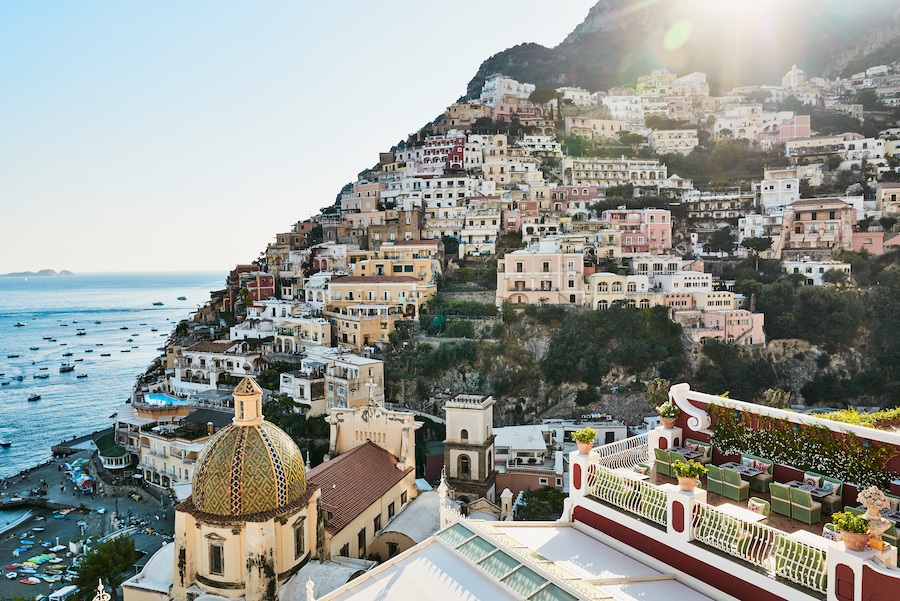
Courtesy of Le Sirenuse.



